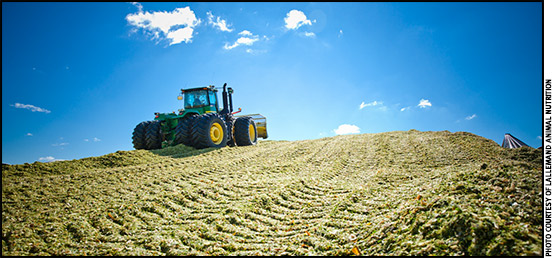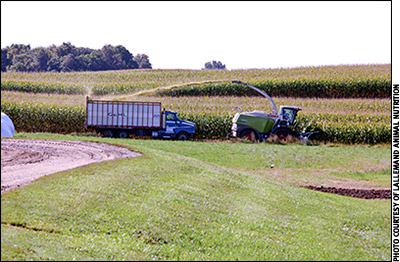
Arm Your Silage with Inoculants
Win the war against bad microbes intent on destroying silage quality and quantity.
Production of quality silage involves winning a war fought on a microscopic level between “armies” of microbes. Inoculants help reinforce the beneficial bacteria in this fight. These products are often lactic acid bacteria (LAB) that provide an efficient front-end fermentation to maintain feed quality and stability. There are many different LAB inoculants to choose from, and growers should select a product that fits:

- the crop being ensiled,
- local conditions,
- farm practices, and
- silage history.
“As a general rule of thumb, you can’t go wrong with an inoculant that drops the pH of the forage as quickly as possible, i.e., making a good fermentation better,” says Renato Schmidt, of Lallemand Animal Nutrition Technical Services. “A rapid pH drop will help maximize dry matter and nutrient retention, plus it will minimize the risk of spoilage.”
To achieve a rapid pH drop, Schmidt recommends looking for homolactic LAB strains such as Pediococcus pentosaceus, P. acidilactici and Lactobacillus plantarum that are proven to convert sugars efficiently to lactic acid.
Next, it’s important to ensure the LAB are not limited for their own food supply, Schmidt recommends. A good inoculant will contain enzymes to help feed bacteria. Also, using the right number of colony-forming units (CFUs) per gram of forage will ensure there are sufficient amounts of “good” microbes that can help growers win the fermentation battle. Look for an application rate of 100,000 CFUs or greater for front-end fermentation inoculants. This is the minimum level, as recognized by university researchers, and is based on using strains proven to dominate the fermentation when used at this level, Schmidt adds.
Third, it’s important to consider the specific crop to be fermented and the harvest conditions. For example, ensiling wet hay crops can easily lead to growth of clostridia and a butyric fermentation. Choosing an inoculant proven to inhibit these types of undesirable fermentations can keep the resulting forage safe to feed.
“In addition, a farm’s specific silage challenges can help determine the best inoculant choice,” Schmidt says. “High-moisture corn or slow feedout rates may suggest an inoculant proven to increase aerobic stability is required to prevent spoilage yeasts.”
For example, L. buchneri 40788 is the only bacteria reviewed by the FDA and allowed to claim improved aerobic stability. Products combining L. buchneri combined with homolactic bacteria can help control the initial ensiling fermentation and keep the feed stable through feeding.
“A forage inoculant is a small investment that can help save many tons of dry matter and improve safety and hygienic quality of the resulting silage,” Schmidt says. “Starting with quality forage and using good management practices — combined with a proven inoculant — can contribute significantly to productivity and profitability.”

Editor’s Note: Wendy Hushon is the North America marketing communications manager for Lallemand Animal Nutrition.





